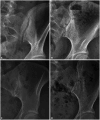Impact of Distal Fusion Level on Sacroiliac Joint Degenerative Change Following Adolescent Idiopathic Scoliosis Surgery
- PMID: 39894043
- PMCID: PMC11790409
- DOI: 10.3349/ymj.2023.0634
Impact of Distal Fusion Level on Sacroiliac Joint Degenerative Change Following Adolescent Idiopathic Scoliosis Surgery
Abstract
Purpose: To evaluate the relationship between distal fusion level in correction and fusion surgery for adolescent idiopathic scoliosis (AIS) and radiologic changes in the sacroiliac (SI) joint.
Materials and methods: This retrospective cohort study evaluated patients who underwent correction and fusion for AIS between 2005 and 2017 with at least 5 years of follow-up. We categorized patients into two groups: Group 1 (distal fusion above L2, 74 patients) and Group 2 (distal fusion at L3 and below, 52 patients). Radiologic parameters and SI joint changes were evaluated on plain radiographs obtained from preoperative to 5 years postoperatively. We also investigated other risk factors for SI joint change.
Results: Analysis of demographic factors revealed no significant difference between the two groups. There was a significant difference in the incidence of SI joint change between Group 1 (5 patients, 6.75%) and Group 2 (18 patients, 34.61%), with Group 2 showing a faster increase in incidence according to the Kaplan-Meier method (p<0.0001). Preoperative lumbar lordosis (LL) and ΔLL had a significant relationship with SI joint changes [preoperative LL, hazard ratio (HR)=0.77, 95% confidence interval (CI)=0.64-0.93, p=0.008; ΔLL, HR=0.79, 95% CI=0.67-0.95, p=0.01).
Conclusion: After AIS surgery, patients who had fusion to the lower lumbar vertebrae (L3 or L4) experienced a higher incidence and faster progression of degenerative changes in the SI joint. Low preoperative LL and inadequate correction of LL during the operation were also risk factors for SI joint degeneration.
Keywords: Adolescent idiopathic scoliosis; distal fusion level; postoperative pain; sacroiliac joint.
© Copyright: Yonsei University College of Medicine 2025.
Conflict of interest statement
The authors have no potential conflicts of interest to disclose.
Figures




Similar articles
-
Is it enough to stop distal fusion at L3 in adolescent idiopathic scoliosis with major thoracolumbar/lumbar curves?Eur Spine J. 2016 Oct;25(10):3256-3264. doi: 10.1007/s00586-015-4373-4. Epub 2016 Jan 13. Eur Spine J. 2016. PMID: 26763009
-
Association of Sagittal Spinopelvic Realignment with Correction in Lower Lumbar Lordosis after Surgical Treatment in Degenerative Lumbar Scoliosis.Orthop Surg. 2021 Oct;13(7):2034-2042. doi: 10.1111/os.13138. Epub 2021 Sep 24. Orthop Surg. 2021. PMID: 34559468 Free PMC article.
-
Postoperative changes in sagittal spinopelvic alignment in sitting position in adolescents with idiopathic thoracic scoliosis treated with posterior fusion: an initial analysis.J Neurosurg Pediatr. 2018 Jul;22(1):74-80. doi: 10.3171/2018.2.PEDS17687. Epub 2018 May 4. J Neurosurg Pediatr. 2018. PMID: 29726791
-
Incidence and risk factors of proximal junctional kyphosis in adolescent idiopathic scoliosis after correction surgery: a meta-analysis and systematic review.J Orthop Surg Res. 2024 Apr 2;19(1):217. doi: 10.1186/s13018-024-04638-7. J Orthop Surg Res. 2024. PMID: 38566085 Free PMC article.
-
Risk factors for adjacent segment degeneration after PLIF.Spine (Phila Pa 1976). 2004 Jul 15;29(14):1535-40. doi: 10.1097/01.brs.0000131417.93637.9d. Spine (Phila Pa 1976). 2004. PMID: 15247575 Review.
References
-
- Bastrom TP, Marks MC, Yaszay B, Newton PO Harms Study Group. Prevalence of postoperative pain in adolescent idiopathic scoliosis and the association with preoperative pain. Spine (Phila Pa 1976) 2013;38:1848–1852. - PubMed
-
- Landman Z, Oswald T, Sanders J, Diab M Spinal Deformity Study Group. Prevalence and predictors of pain in surgical treatment of adolescent idiopathic scoliosis. Spine (Phila Pa 1976) 2011;36:825–829. - PubMed
MeSH terms
LinkOut - more resources
Full Text Sources
Medical

